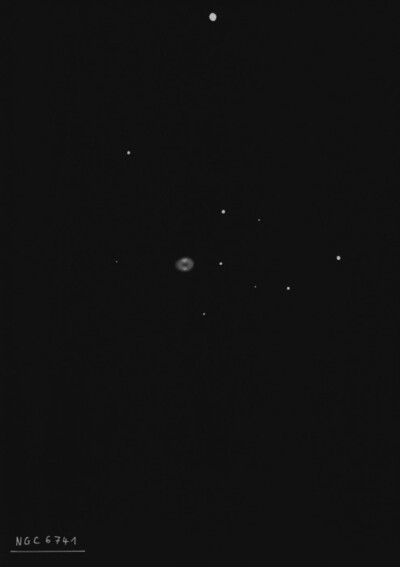Phantom Streak Nebula
Phantom Streak Nebula

Edward Pickering discovered NGC 6741 on 19 Aug 1882 using a direct-vision spectroscope with the 15-inch refractor at Harvard College Observatory. The discovery was announced in AN 2459 and The Observatory, Vol 5, for Oct 1882.
Robert Jonckheere mistakenly catalogued this object as a double star (J 475) in 1911, based on observations with the 14-inch equatorial refractor at the University of Lille. The following year he reobserved it with the 28-inch Greenwich refractor and realized it was nebulous and identical to the planetary NGC 6741 (see http://articles.adsabs.harvard.edu/cgi-bin/nph-iarticle_query?1915Obs....38..478J).
Based on Crossley photographs at Lick, Curtis (1918) reported "No central star. A small bright oval, 9"x7" in p.a. 95°. It shows traces of an indistinct ring structure, being somewhat fainter along the major axis. There is a small, scarcely perceptible protuberance at the western end."
John Mallas coined the nickname "Phantom Streak" in his Jun/Jul 1963 article "Visual Atlas of Planetary Nebula-V", published in the "Review of Popular Astronomy". He writes: The "Phantom Streak." First you see it and then you don't...In the 4-inch looks like a broad silver line. Almost uniform in brightness, the ends appear broken and diffused...My visual impression agrees with H.D. Curtis's description of this object. He states "It shows some trace of a ring structure, being somewhat fainter along the major axis."
400/500mm - 17.5" (7/16/93): fairly bright, very small, round, clearly non-stellar at 220x, fairly high surface brightness, greenish tinge. Set in a rich field with several stars near including a mag 12 star 35" NNW, a mag 14 star 20" W and a mag 15 star 30" SW. A striking equal magnitude double star ∑2434 = 8.5/8.5 at 24" is located 15' S. At 410x, the easily visible disc is slightly elongated ~E-W. The PN forms the SE corner of a rough parallelogram with three brighter mag 11-12 stars 2.7' N, 4' WSW and 4' WNW and several other faint stars are near. The planetary has an irregular surface brightness but no clear structure. Estimate V = 11.0-11.5.
600/800mm - 24" (9/1/16): easily picked up at 200x as a very small, soft bluish glow. At 500x (unfiltered) the planetary appeared fairly bright, small, slightly elongated E-W, ~8"x6", brighter along the rim on the north side. There was no sign of a central star or any superimposed stars. A mag 13 star is 34" NW, a mag 14 star is 18" W and a mag 14.5 star is 25" SSW. Located 16' N of ∑2434, a wide pair of mag 8.5 stars at 27" separation.
Notes by Steve Gottlieb